Saphenion®: Neue Therapieoption – Das Olympus RFITT – Precision – System
Saphenion®: Neue Therapieoption – Das RFITT – Precision-System – Die moderne Venentherapie bei Krampfadern ist schonend, effektiv und endovenös. Als Venenzentrum haben wir uns dieser modernen Venentherapie bereits seit 2002 verschrieben. Wir haben eine Zertifizierung für die RFITT – Radiowellentherapie und die VenaSeal®-Closure Therapie. Dabei werden Venen schonend verklebt. Für uns ist der Einsatz des Venenklebers bei der simultane Therapie mehrerer Stammkrampfadern sowohl bei der Vena saphena magna als auch bei der Vena saphena parva inzwischen Therapie der ersten Wahl.
Das RFITT – Verfahren (Radiofrequenzinduzierte Thermotherapie) der ersten und zweiten Generation haben wir seit 2007 an 2800 Stammkrampfadern eingesetzt. Darüber hinaus haben wir dieses System erfolgreich bei der Behandlung von Kniegelenkzysten (sog. Bakerzysten) eingeführt.
Das bipolare RFITT Precision System findet auch Anwendung bei: Tumorablation (Leber, Lunge, Niere, Prostata, Brust), Schilddrüse (kalte/ heiße Knoten), Facettengelenksdenervationen und der Therapie des Nasensegels (HNO).
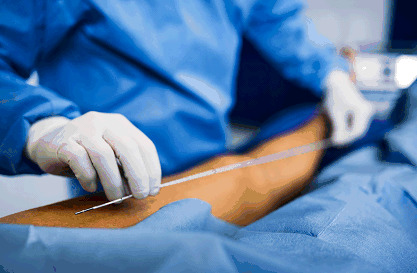
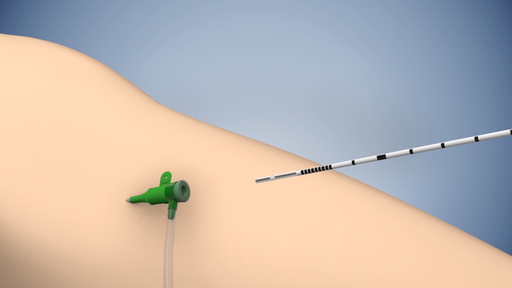
Saphenion®: Neue Therapieoption – Das Olympus RFITT – Precision System
Die bipolare Radiofrequenzablation hat sich in den vergangenen 19 Jahren als eine schonende Behandlung der Stammkrampfadern entwickelt. Seit Kurzem ist das RFITT – System Celon Precision auf dem Markt. Das Neue ist, dass sich dieses System in seiner Temperaturabgabe selbst reguliert. Durch die kontinuierliche Impedanzmessung wird der Zustand der Venenwand analysiert und die Energieabgabe erfolgt selbstregulierend, automatisch.
Diese herausragende Eigenschaft der Impedanzmessung und die dadurch mögliche Selbstkontrolle des Systems ermöglichen erstmals bei einem thermischen Verfahren eine weitgehend komplikationslose und nebenwirkungsarme Ablation der Krampfader, ohne dass eine Tumeszenzanästhesie in das Gewebe gespritzt werden muss. Die Impedanz erhöht sich bei fortschreitender Schrumpfung der Vene und der Generator reduziert die Leistung automatisch. Dadurch ist eine wesentlich bessere Kontrolle und schonendere Therapie der Vene möglich. Thermische Schäden am umliegenden Gewebe (Nerven, Lymphbahnen, Fettgewebe) werden vermieden. Bei einem definierten Impedanzwert schaltet eine sog. Auto-Stopp-Funktion die Energieabgabe selbststeuernd ab.
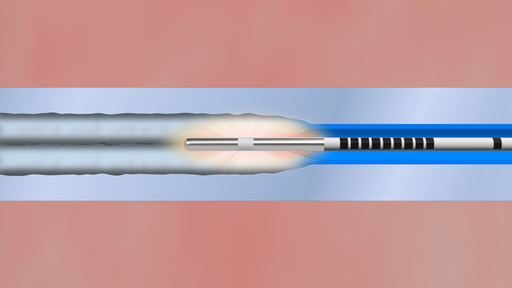
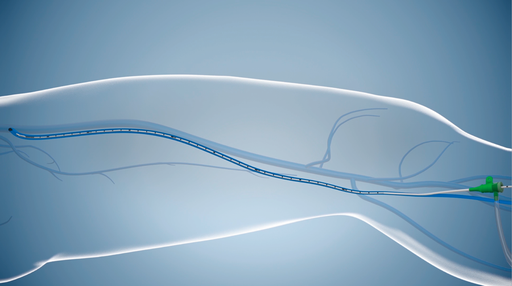
Graphische Darstellung der Funktion des bipolaren Katheters und anatomische Situation während der Therapie.
Saphenion®: New therapy option: Graphical representation of the function of the bipolar catheter and anatomical situation during therapy
Bei der bipolaren Radiofrequenzablation fließt Strom zwischen den beiden Elektroden (Länge 18mm), der Durchmesser des Kathetersystems beträgt lediglich 1,8 mm. Der katheter ist dicht an der Veneneinmündung positionierter, da keine Wärmeabstrahlung in die tiefen Venen erfolgt. Der Ablationsvorgang beginnt bei 100°c und reguliert sich selbst entsprechend der Impedanzänderung herunter. So ist eine sog. grossflächige Tumeszenzanästhesie, wie sie beim Laser und SONOVEIN oder auch den monopolaren Radiofrequenz – Systemen zwingend ist, hier nicht erforderlich. Somit haben wir, wie beim Venenkleber auch, für unsere Venenzentren einzig die Gabe einer Beruhigungsspritze festgelegt.
Saphenion®: Neue Therapieoption – Fakten zum RFITT Precision System:
Der bipolare RFITT – Katheter entwickelt eine therapeutische Wärme von 60 – 90 °C. Dazu zum Vergleich die Wärmeentwicklung des Venenklebers ca. 50°C, des Lasers ca. 300 – 900°C, des ClosureFast-Systems 120°C. Die Energie tritt bei Aktivierung nur am Bipol auf, sofortige Temperatursenkung ohne Aktivierung auf unter 40°C an der Sondenspitze
Weiterhin erhält der therapierende Arzt akustische und optische Hinweise auf der Impedanzanzeige – es wird der Trocknungsgrad der Intima gemessen. Durch die permanente Impedanzmessung – bei Anstieg des Widerstandes (korreliert mit Trocknungsgrad) – sofortige Energieunterbrechung und Abkühlung der Katheterspitze. Die Impedanzmessung erfolgt nach dem physiologischen Zustand der Venenwand – nicht zeitgesteuert. Dadurch ist keine Verbrennung bzw. Karbonisierung des Gewebes (wie z.b. beim Laser) möglich.
Bei der Therapie der Vena saphena magna ist keine Tumeszens zur Kühlung erforderlich, außer bei sehr oberflächlichem Venenverlauf, bei der Vena saphena parva ist eine Kühlung empfohlen, um neurologische Missempfindungen zu vermeiden. Die Sondenlänge von 1,2 m ist auch für lange Venensegmente geeignet. Bereits bei Venenabschnitten von 3 cm Länge (Verbindungsvenen, Rezidivkrampfadern) ist ein segmentales Arbeiten mit dem RFITT – Katheter möglich.
Und ebenfalls wichtig: Die Kosten des Katheters betragen ein Drittel der Kosten des SONOVEIN – Ultraschallkopfes oder des VenaSeal – Katheters. Damit eignet sich dieses System unter klinischen funktionellen und wirtschaftlichen Aspekten sehr gut für die Therapie an einer bis zwei Stammvenen, im Besonderen der Vena saphena magna und der Akzessoriavenen. Damit wird das System auch einer größeren Zahl an Patienten zugänglich – ohne therapeutische Einschränkungen.
Der Einsatz des neuen Kathetersystems erfolgt seit dem 2020 am Standort in Rostock. Die Indikation im Venensystem ist identisch mit der beim Venenkleber, einschließlich kurzer Restvenenstämme und Verbindungsvenen. Darüber hinaus können wir somit auch Bakerzysten im Gefäß-Venenzentrum Rostock therapieren.
Saphenion®: New therapy option
SaphenionPatientInfo—New therapy option: The RFITT Precision System—Modern venous therapy for varicose veins is gentle, effective, and endovenous. As a venous center, we have been committed to this modern varicose vein therapy since 2002. We are certified for RFITT radio-wave therapy and VenaSeal® Closure therapy. The veins are glued gently. For us, using vein glue for the simultaneous treatment of multiple varicose veins is now the first choice for the great saphenous and small saphenous veins.
Since 2007, we have used the first and second-generation RFITT (radio frequency induced thermotherapy) procedure on 2,400 varicose veins. We have also successfully introduced this system in the treatment of knee joint cysts (so-called Baker`s cysts).
The bipolar RFITT Precision System is also used for tumor ablation (liver, lungs, kidney, prostate, breast), thyroid (cold/hot nodes), facet joint denervations, and nasal sail therapy.
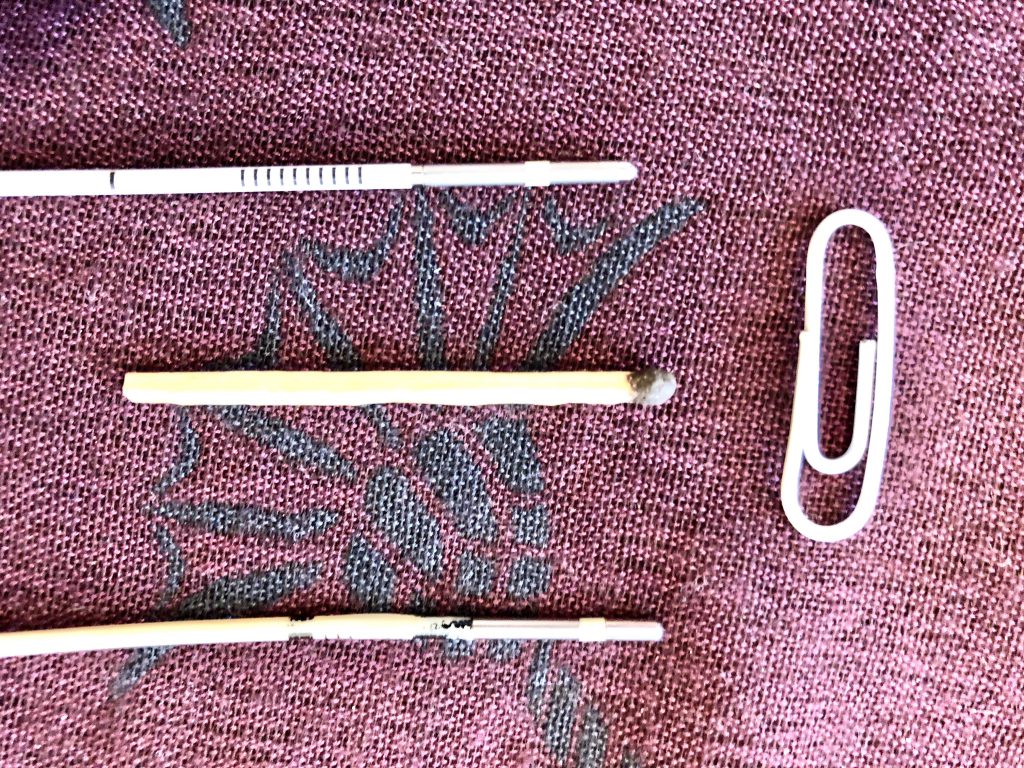
SaphenionPatientInfo – New therapy option: Photo to compare the size of the catheters, old RFITT catheter on top, a match in the middle, and a small paper clip, below a new RFITT Precision Catheter
Saphenion®: New therapy option – The RFITT – Precision System
Bipolar radio-frequency ablation has developed over the past 19 years as a gentle treatment for varicose veins. The RFITT Precision system has recently been launched. The new thing is that this system regulates itself in its temperature emission. The condition of the vein wall is analyzed by the continuous impedance measurement, and the energy output is self-regulating automatically.
This outstanding property of the impedance measurement, and the self-control of the system that is possible as a result enable ablation of the varicose vein without complications, and with few side effects for the first time in a thermal process, without the need to inject tumescent anesthesia into the tissue. The impedance increases as the vein shrinks, and the generator automatically reduces the power. This enables much better control and gentler treatment of the vein. Thermal damage to the surrounding tissue (nerves, lymph channels, fat tissue) is avoided. With a defined impedance value, a so-called auto-stop function switches off the energy output in a self-controlling manner.
With bipolar radiofrequency ablation, current flows between the two electrodes (length 18 mm). The diameter of the catheter system is only 1.8 mm. The catheter is positioned close to the vein opening because there is no heat radiation in the deep veins. The ablation process begins at 90° C and regulates itself down according to the change in impedance. So-called large-area tumescent anesthesia, as is mandatory with lasers and SONOVEIN or with monopolar radiofrequency systems, is not necessary here. Thus, as with vein glue, we only decided to give a sedative syringe to our Vein Care Centers.
Saphenion®: New therapy option – Facts about the RFITT Precision System:
The bipolar RFITT catheter develops a therapeutic warm of 60 – 90 ° C. For comparison, the heat development of the vein glue is approx. 50 ° C, the laser approx. 300 – 900 ° C, the ClosureFast – system 120 ° C. When activated, the energy only occurs at the bipole, with immediate temperature reduction without activation to below 40 ° C at the probe tip.
The treating physician also receives acoustic and visual information on the impedance display. The degree of dryness of the intima is measured. Due to the permanent impedance measurement, when the resistance increases (correlates with the degree of dryness), immediate energy interruption and cooling of the catheter tip will come. The impedance measurement is based on the physiological state of the vein wall, not time-controlled. This means the tissue cannot be burned or carbonized (such as with a laser).
For the therapy of the great saphenous vein, no tumescence is required for cooling, except in the case of a very superficial course of the vein. In the case of the small saphenous vein, cooling is recommended to avoid neurological abnormalities. The probe length of 1.2 m is also suitable for long vein segments. Segmental work with the RFITT catheter is already possible with vein sections of 3 cm in length (perforator veins, recurrent varicose veins).
Also important: The cost of the catheter is one-third of the cost of the SONOVEIN ultrasound head or the VenaSeal catheter. This makes the system very useful from a clinical functional and economic point of view for therapy on one or two trunk veins, in particular the GSV and the accessory veins. This makes the system accessible to a larger number of patients – without therapeutic restrictions.
The new catheter system will be used from 2020 in Rostock. The indication in the varicose vein system is identical to that for vein glue, including short residual truncal veins and perforator veins. Also, we can treat Baker’s cysts in both practices at the beginning of the new year.
Photos: Utzius, Olympus
Video: Olympus
Links / Papers
Nyamekye IK, Dattani N, Hayes W, Harding D, Holloway S, Newman J. A Randomised Controlled Trial Comparing Three Different Radiofrequency Technologies: Short-Term Results of the 3-RF Trial. Eur J Vasc Endovasc Surg. 2019 Sep;58(3):401-408. doi: 10.1016/j.ejvs.2019.01.033. Epub 2019 Jul 24. PubMed PMID: 31351832.
Badham GE, Dos Santos SJ, Whiteley MS. Radiofrequency-induced thermotherapy
(RFiTT) in a porcine liver model and ex vivo great saphenous vein. Minim Invasive
Ther Allied Technol. 2017 Aug;26(4):200-206. doi: 10.1080/13645706.2017.1282520.
Epub 2017 Feb 2. PubMed PMID: 28151029.
http://www.gefaesscentrum-koeln.de/wp-content/uploads/2014/12/Phlebologie2009.pdf
